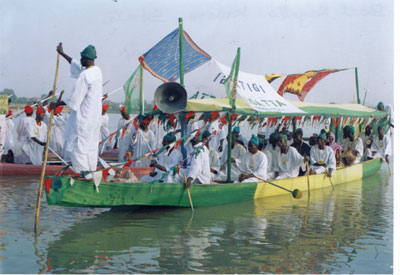 Saminaka’s September is going to be rife with preparations, for October 1 is Nigerian National Day! And as we are a Virtual Nigeria, it’s celebration time! We’re planning all kinds of exciting activities for our upcoming first annual African Festival!!! In the upcoming weeks the Compass will feature stories about some of our featured activities, which begin the evening of Oct. 1 and conclude Oct. 4.
Saminaka’s September is going to be rife with preparations, for October 1 is Nigerian National Day! And as we are a Virtual Nigeria, it’s celebration time! We’re planning all kinds of exciting activities for our upcoming first annual African Festival!!! In the upcoming weeks the Compass will feature stories about some of our featured activities, which begin the evening of Oct. 1 and conclude Oct. 4.
What do you think of when you hear the word “regatta”? Yachts with sails ballooning? Power boats full of laughing passengers, chugging in a line up the river? Well, abandon all those thoughts and paint yourself a new regatta! Nigeria’s riverine peoples have a tradition of decorating their canoes for exciting displays of color, dance and rhythmic paddle slapping.
West African canoes are dugouts, made from single hollowed tree trunks. In many countries—Ghana, Ivory Coast, Cameroon, Benin Republic, Togo—they are painted or otherwise ornamented with carved segments. Beach visitors are struck by their picturesque qualities, and Flickr is full of tourist shots of these attractive boats--but a flotilla of canoes with even more elaborate embellishments seems to be exclusively Nigerian.
 While many canoes are small, meant for individual transport and fishing, the dugouts used for regattas are usually larger. In the days before other transport, huge canoes were used for long-distance trade or war parties. They could hold up to 30 people, or be loaded with foodstuffs, cloth and other goods. Regattas developed as a social version of the cavalcades of soldiers and merchants, with paddlers dressed alike, their canoes decorated with awnings, pennants, and dancers on attached platforms.
While many canoes are small, meant for individual transport and fishing, the dugouts used for regattas are usually larger. In the days before other transport, huge canoes were used for long-distance trade or war parties. They could hold up to 30 people, or be loaded with foodstuffs, cloth and other goods. Regattas developed as a social version of the cavalcades of soldiers and merchants, with paddlers dressed alike, their canoes decorated with awnings, pennants, and dancers on attached platforms.
Stanley noted a display of war canoes in 19th century Uganda: "The largest canoe seen by me in this fleet measured 72 feet in length, 7 feet three inches in breadth...There were probably over a hundred canoes between 50 and 70 feet in length, and about 50 between 30 and 50 feet long...The largest class--100 in number--would require on an average fifty men each to man them." The various Nigerian fleets were comparable
 The Ijo, Itsekiri, riverine Yoruba and Nupe take part in regattas for special occasions—distinguished visitors, holidays, coronation anniversaries and more. They have a competitive element, each vying to inject more eye-catching displays that the next, with prizes awarded to the winners. The sight of a graceful canoe riding low in the water, paddlers slapping a percussive salvo on the waves in perfect unison, would be glorious enough, but some are rigged with revolving elevated sections, women dancing aloft for visibility. At other times, a dancer will take to the prow, vigorously performing in a precarious location. Dance in riverine areas is extremely graceful, inspired by the balance developed by canoe use. It often employs a position bent at the waist, and when performed in a canoe requires a delicate set of calculations to ensure neither the canoe nor the dancer are overset.
The Ijo, Itsekiri, riverine Yoruba and Nupe take part in regattas for special occasions—distinguished visitors, holidays, coronation anniversaries and more. They have a competitive element, each vying to inject more eye-catching displays that the next, with prizes awarded to the winners. The sight of a graceful canoe riding low in the water, paddlers slapping a percussive salvo on the waves in perfect unison, would be glorious enough, but some are rigged with revolving elevated sections, women dancing aloft for visibility. At other times, a dancer will take to the prow, vigorously performing in a precarious location. Dance in riverine areas is extremely graceful, inspired by the balance developed by canoe use. It often employs a position bent at the waist, and when performed in a canoe requires a delicate set of calculations to ensure neither the canoe nor the dancer are overset.

Regattas and festivals are a natural fit, so we want to have one for our African Festival! Through the kindness of Carricre Wind, we have a supply of modifiable simple dugouts. It is up to you, dear readers, to transform them from serviceable crafts to things of beauty, to staff them with similarly dressed friends and dancers or man them alone. Paint them, deck them with fluttering cloths, do what you will. They are available in a box at Saminaka’s infohub throughout September, so ready yourself! When the Festival event times are finalized, come and participate or watch, and be in the running for some splendid prizes!
Get a look at the real thing with this short video from the Ijo city-state of Nembe:
http://www.youtube.com/watch?v=ASWikKDouIQAnd pick up your canoe, ready for growth, painting and decoration at: http://slurl.com/secondlife/Saminaka/57/157/22





No comments:
Post a Comment